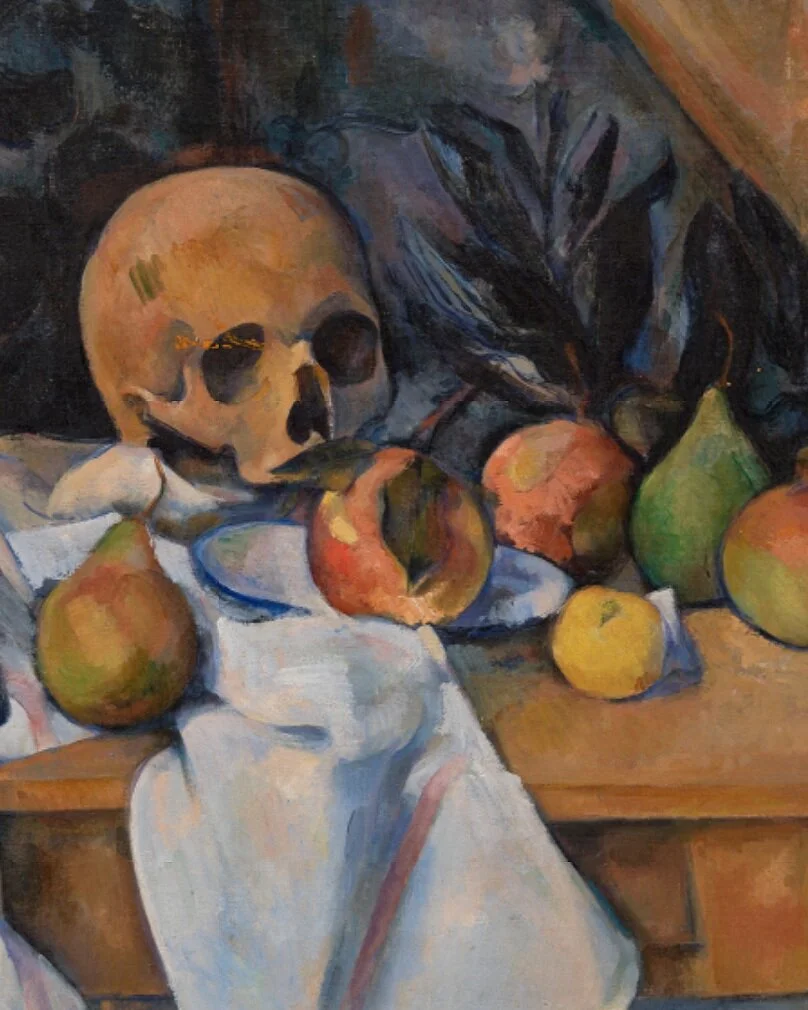Rx 44 / Card Players
The world of play, to which art belongs, stands in most important and interesting contrast with the stern realities of life.
— Karl Groos
Visitors to the Barnes Foundation encounter Paul Cézanne’s (1839–1906) The Card Players almost immediately upon entering the collection’s main gallery. Life-size figures occupy the massive painting, hung on the west wall; the empty fourth side of the table invites the viewer to sit down and, perhaps, join in. Indeed, it appears as if we’ve happened upon a gathering of field hands—assumed to be employed at the Cézanne family estate in Aix-en-Provence—focused intently on a game of cards. Unlike earlier depictions of card playing, such as Caravaggio’s The Cardsharps, the players are not active or animated; they exist, endlessly, in anticipation of their next move, which we imagine immediately follows this scene. The stoicism and monumental scale ennobles the humble players to a status usually reserved for grander subjects like history or mythology.
Caravaggio (Michelangelo Merisi), The Cardsharps, c. 1595. Kimbell Art Museum.
“Without the usual moral lesion, extraneous realist details and gestural expressivity,” writes art historian André Dombrowski, card playing is “instead condensed by Cézanne into grave and concentrated action and form.” This meticulously crafted composition of pictorial setness and counterbalance (note, for example, the voluminous gold drapery at far right and bright red kerchief on the standing figure) was prefaced by several preparatory works and sketches, including single-figure studies of each model. Technical analysis of a related Card Players painting performed by The Metropolitan Museum of Art revealed Cézanne likely constructed these scenes on his own; this game presumably never took place. Instead, this is an intentional study of architecture and geometry.
Cézanne painted this commanding work, believed to be the second, and largest, in a series of five, when he retired from Paris to Aix, where he produced much of his later oeuvre. The Provençal artist often took inspiration from local peasants, such as those depicted here, and from nearby landscapes— Mont Sainte-Victoire was a favorite—which he painted constantly throughout his life. Unlike the burgeoning metropolis of late nineteenth-century Europe, Aix appealed immensely to Cézanne for its slower, simpler way of life. Eliding action or narrative, this solemn, unromantic scene conveys the rituals of a people and place that, for Cézanne, would remain timeless.
reflections…
Cézanne’s focus on the card playing motif builds upon a tradition from seventeenth and eighteenth-century genre painting, revealing an interest in the role of chance and contingency in everyday life. As Margaret Iverson writes, “One might plausibly maintain that since the game involves a mixture of chance and choice, accident and skill, it models perfectly Cézanne’s manner of painting.” We might say the same of medicine: some combination of logic and luck often determines the course of patient care. This can be a challenging truth to reconcile, as our society, and medicine in particular, strive for certainty and control. That entities like cancer can be stochastic and aleatory, and despite our best efforts (i.e., lifestyle modification, risk factor prevention), the worst can still happen; in other words, sheer randomness in the form of senseless tragedy can find anyone. As Barbara Boggs Sigmund said of her metastatic melanoma diagnosis, “Evil, illness, accident, injustice and bad luck strike the self-improved and unimproved alike.”
How can physicians and patients become more comfortable embracing the sizable role of chance in clinical care? How might incorporating chance into diagnosis conversations help assuage patient anguish, set realistic expectations, yet still leave room for hope?
As Dombrowski argues, around the time Cézanne produced The Card Players in the 1890s, anthropologists and psychologists theorized that play and games were a central component of human socialization. Although Cézanne was likely unaware of these developments, “the existence of this body of thought underscores that the very profundity and nobility that Cézanne gave to the card game...as a central and indispensable (qua ‘instinctual;) preoccupation in life […] Cézanne...can be said to emphasize that play is not a mere frivolity and leisure activity, but a central tool of human consciousness, learning and association, on the same level as art.”
Indeed, Cézanne depicted a representation of workers not at work, but partaking in leisurely after-work scenes, at the tavern or playing cards. We might think of the card players as resisting modern industrial life, including its demands of constant productivity and efficiency. In focusing on the simple act of being, Cézanne elevates and imbues dimensionality to identity beyond one’s vocation. How can we apply a similar lens to healthcare workers, particularly at this moment when chaotic scenes of caring for the critically ill permeate our visual lexicon? In other words, how might representing the clinician experience as confined to the intensive care unit or the wards ultimately be detrimental to healthcare worker well-being? How can we create space for a more holistic portrayal that affirms the meaningfulness of dedicating one’s professional life to the care of others? How can we avoid the tendency to romanticize caregiving as a heroic act of self-sacrifice?
sources
Padiyar, Satish. (2013). Modernist Games: Cézanne and his Card Players. London: Courtauld Books Online.
“Paul Cézanne, The Card Players (Les Joueurs de cartes).” (2021). Barnes Foundation. https://collection.barnesfoundation.org/objects/6992/The-Card-Players-(Les-Joueurs-de-cartes)/.
Boggs Sigmund, Barbara. “I Didn't Give Myself Cancer.” The New York Times. December 30, 1989. https://www.nytimes.com/1989/12/30/opinion/i-didnt-give-myself-cancer.html.









